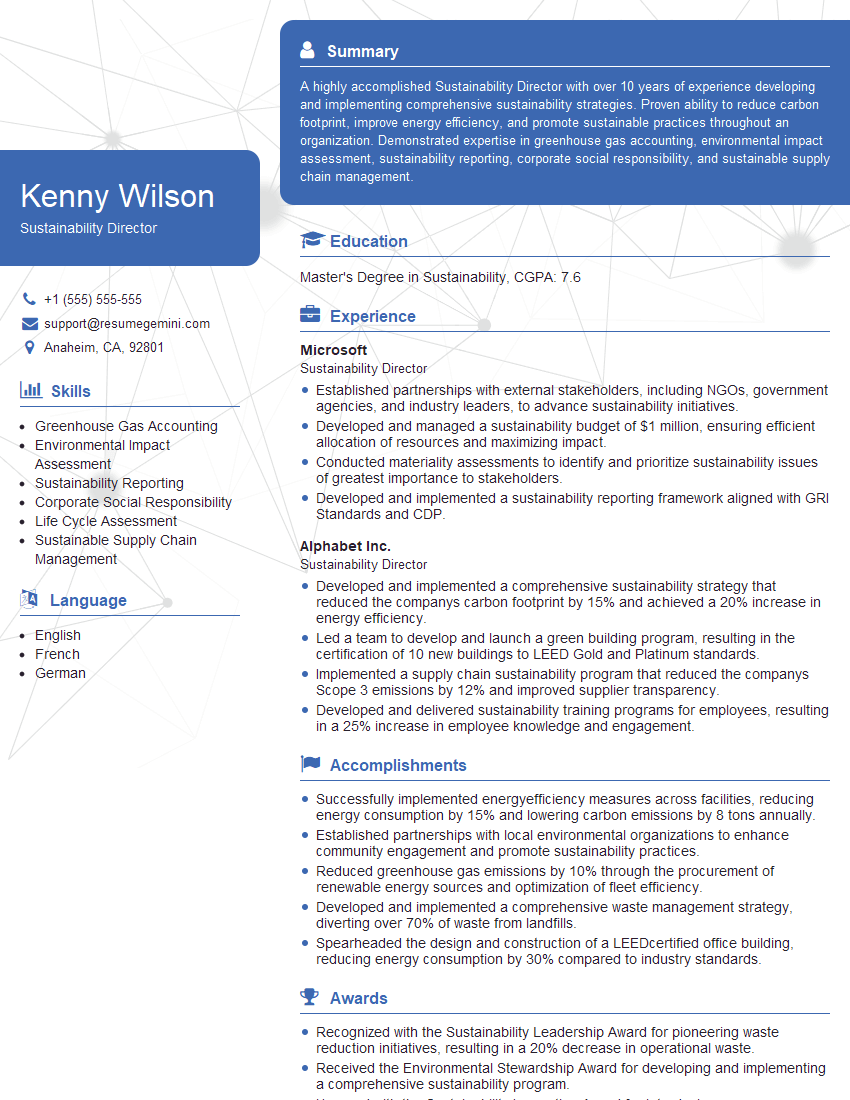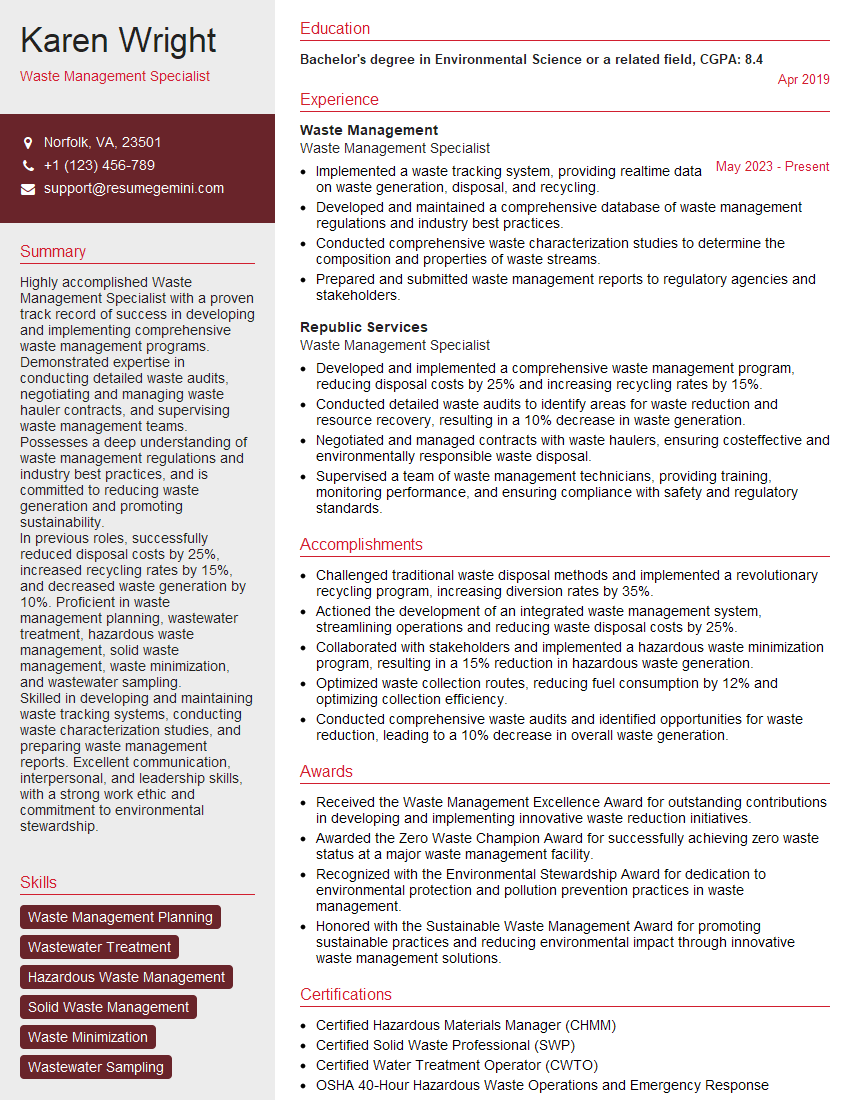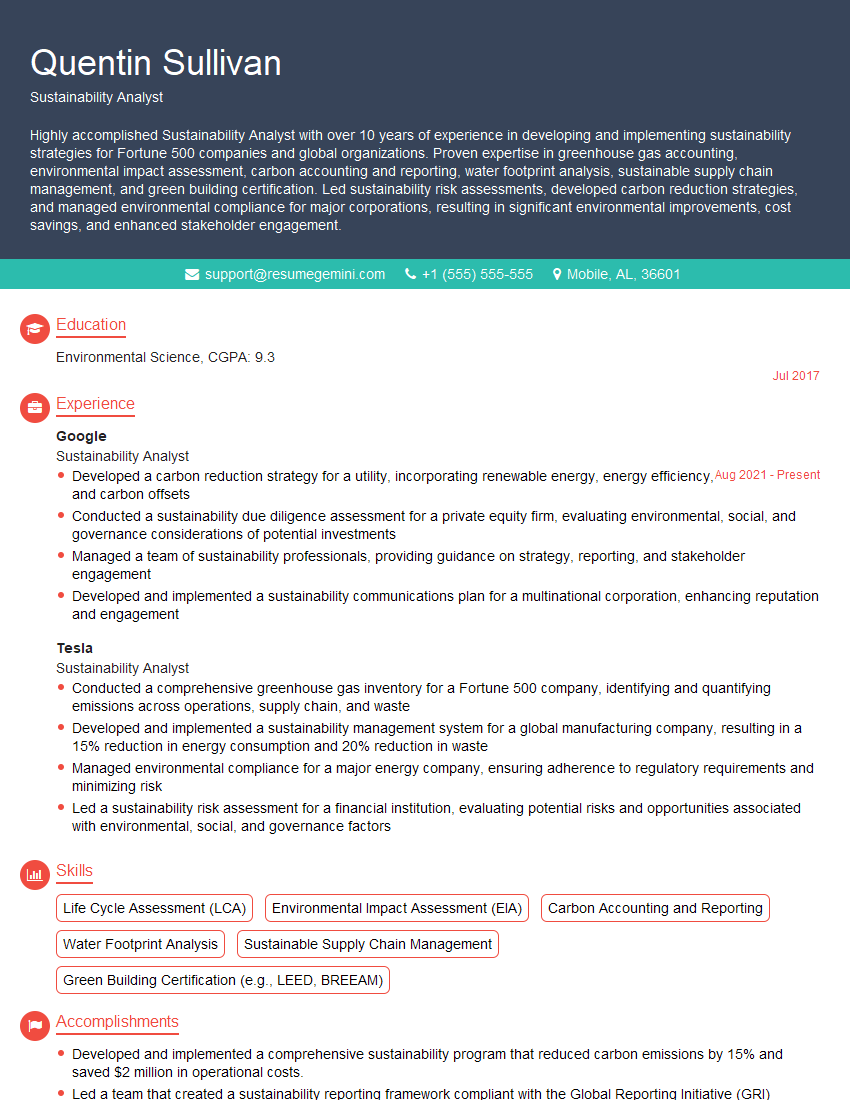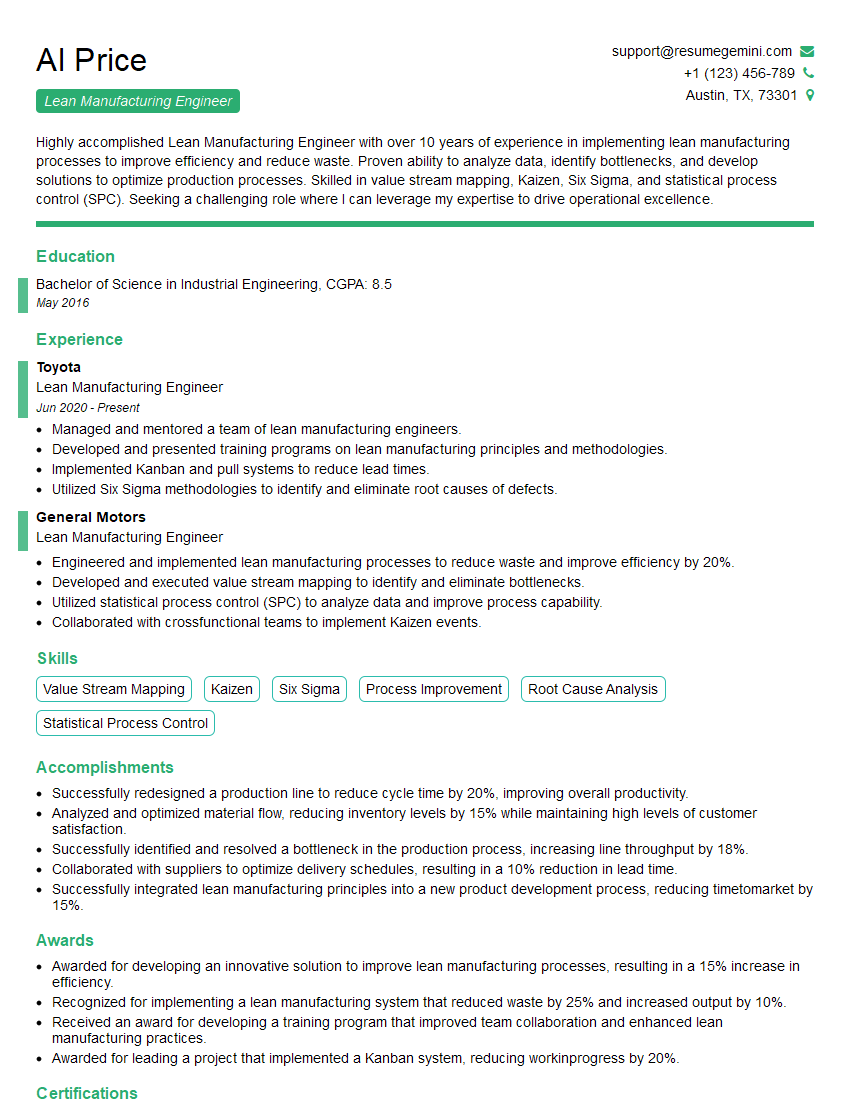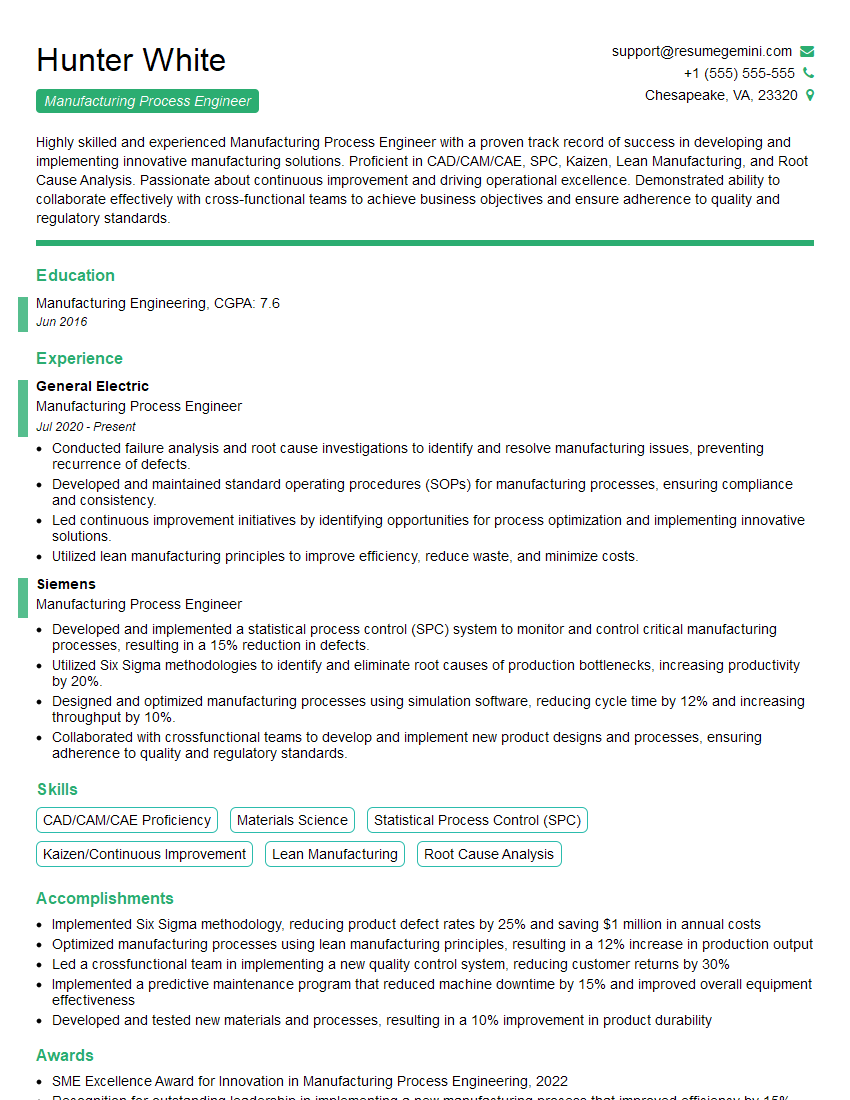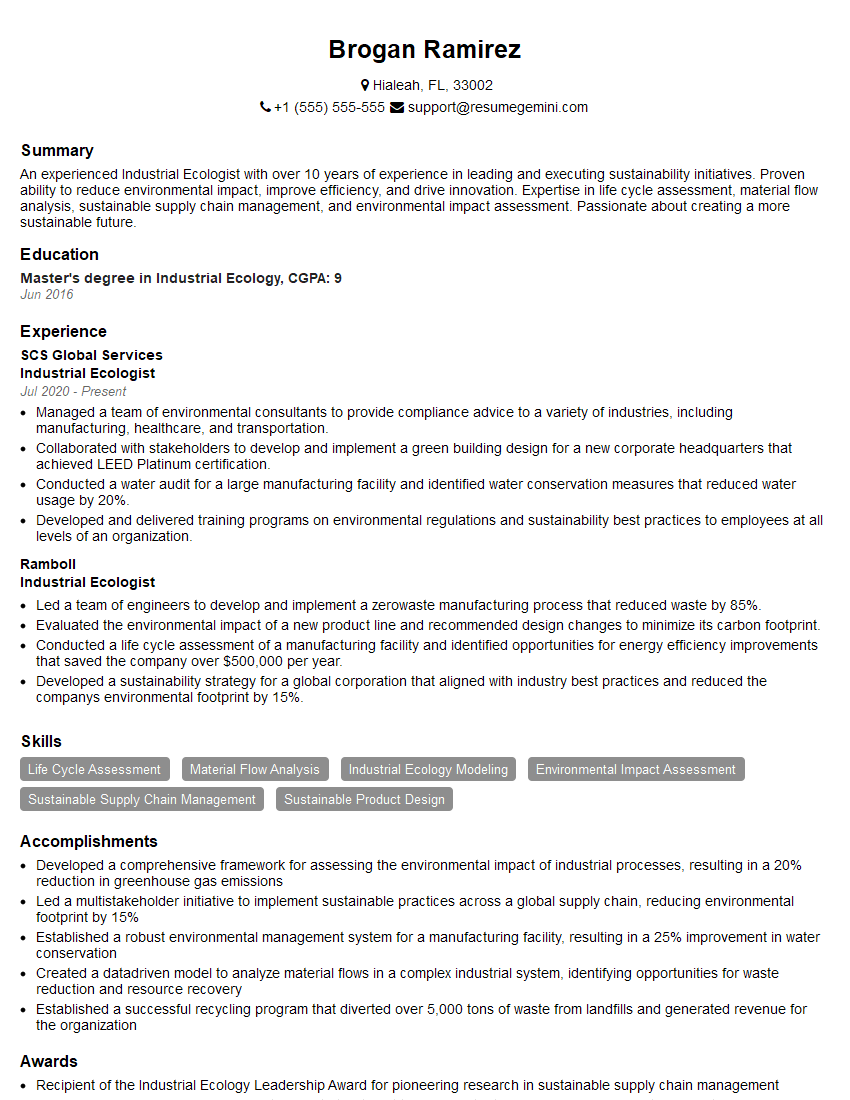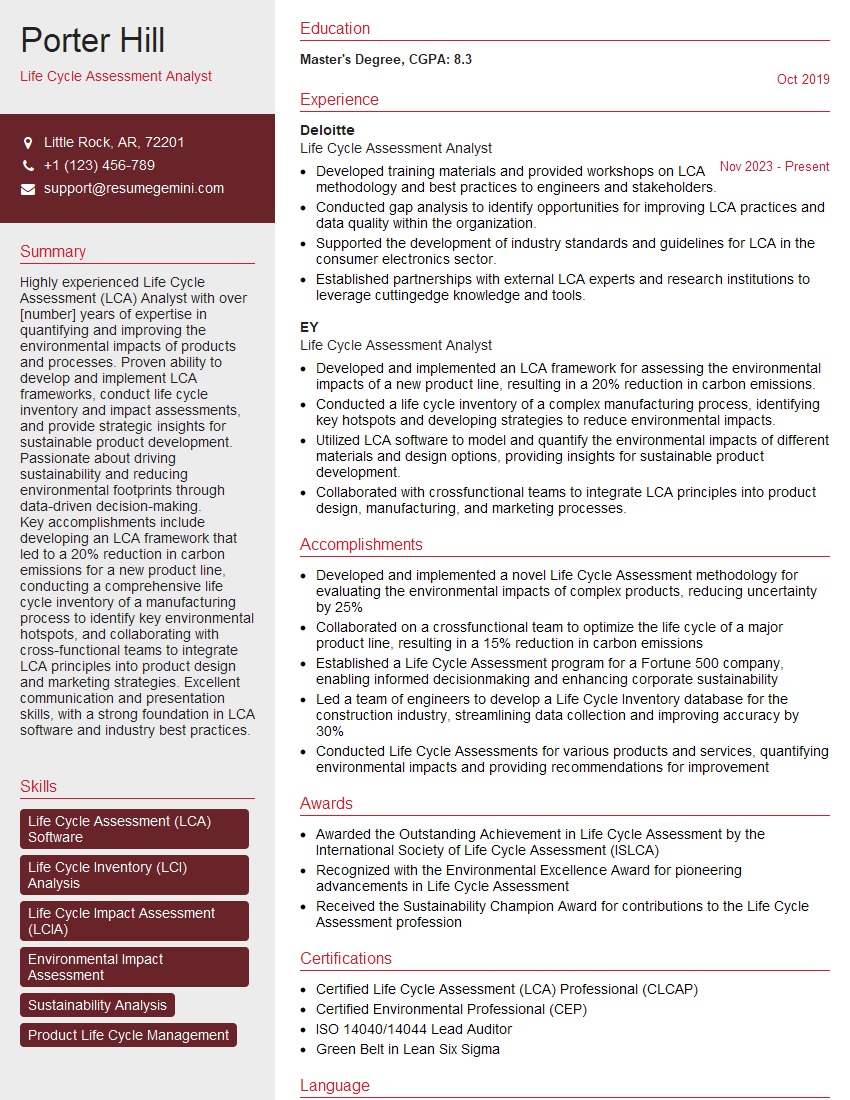Interviews are more than just a Q&A session—they’re a chance to prove your worth. This blog dives into essential Sustainable Manufacturing Practices interview questions and expert tips to help you align your answers with what hiring managers are looking for. Start preparing to shine!
Questions Asked in Sustainable Manufacturing Practices Interview
Q 1. Describe your experience implementing Lean Manufacturing principles to reduce waste.
Lean Manufacturing focuses on eliminating waste throughout the entire production process. My experience implementing Lean principles involved a multi-faceted approach. In a previous role at a food processing plant, we utilized value stream mapping to identify bottlenecks and areas of excessive inventory. This involved visually mapping the entire production flow, from raw materials to finished goods, highlighting areas where time, materials, or effort were wasted. We then implemented solutions such as 5S (sort, set in order, shine, standardize, sustain) to improve workplace organization, reducing search time and improving efficiency. Furthermore, we introduced Kanban systems to manage inventory levels more effectively, minimizing excess stock and preventing shortages. This resulted in a 15% reduction in production lead times and a 10% decrease in waste materials, significantly boosting productivity and profitability.
For example, in one specific area, we identified excessive waiting time between processing steps. By reorganizing the workflow and implementing a pull system (Kanban), we eliminated this downtime, resulting in a noticeable reduction in both time and resource waste. The success of this initiative was measurable through key performance indicators (KPIs) such as reduced inventory levels, decreased production cycle time, and improved overall equipment effectiveness (OEE).
Q 2. Explain the concept of Life Cycle Assessment (LCA) and its application in manufacturing.
Life Cycle Assessment (LCA) is a comprehensive method for evaluating the environmental impacts associated with a product, process, or service throughout its entire life cycle. This encompasses all stages, from raw material extraction and processing to manufacturing, transportation, use, and eventual disposal or recycling. In manufacturing, LCA is crucial for identifying environmental hotspots – stages where the greatest environmental impacts occur. This allows for targeted improvements in sustainability.
For instance, an LCA of a plastic bottle would consider the energy used in creating the plastic resin, the water consumption during manufacturing, the transportation emissions, the environmental impact during its use, and its eventual disposal (landfill, incineration, or recycling). The results of an LCA are typically presented as an inventory of environmental impacts, including greenhouse gas emissions, water use, energy consumption, and waste generation. This data can inform design choices, process optimization, and the selection of more sustainable materials and technologies. Ultimately, conducting LCAs allows businesses to make informed decisions that minimize their environmental footprint and improve their overall sustainability performance.
Q 3. How would you measure the environmental impact of a manufacturing process?
Measuring the environmental impact of a manufacturing process requires a multi-pronged approach. We can use a combination of quantitative and qualitative methods to assess the impact. Key quantitative measures include:
- Greenhouse gas emissions (GHGs): Measured in tons of CO2 equivalent (tCO2e), this assesses the contribution to climate change.
- Energy consumption: Measured in kilowatt-hours (kWh), this reflects the energy intensity of the process.
- Water usage: Measured in cubic meters (m³), this assesses water scarcity impacts.
- Waste generation: Measured in weight (kg) and categorized by type (hazardous, non-hazardous), this tracks waste disposal challenges.
- Resource depletion: This involves assessing the consumption of raw materials and their impact on natural resources.
Qualitative assessments involve evaluating factors like compliance with environmental regulations, waste management practices, and the overall environmental management system in place. By combining quantitative data with qualitative assessments, we obtain a comprehensive picture of the environmental impact of the manufacturing process. This data can then be used to develop targeted strategies for improvement.
Q 4. What are the key metrics used to track sustainability performance in manufacturing?
Several key metrics are used to track sustainability performance in manufacturing. These can be broadly categorized into environmental, social, and economic indicators. Examples include:
- Environmental Metrics: GHG emissions per unit produced, water consumption per unit, waste generation per unit, energy intensity, percentage of recycled materials used.
- Social Metrics: Employee safety incidents, community engagement initiatives, supplier ethical sourcing practices.
- Economic Metrics: Cost savings from waste reduction, revenue from green products, investment in sustainable technologies.
Tracking these metrics provides a holistic view of sustainability performance and allows for continuous improvement. Regular reporting and benchmarking against industry best practices are crucial for effective tracking and demonstrating progress towards sustainability goals.
Q 5. Describe your experience with ISO 14001 or other environmental management systems.
In a previous role, I led the implementation of ISO 14001, an internationally recognized standard for environmental management systems (EMS). This involved conducting an environmental impact assessment, defining environmental objectives and targets, developing and implementing environmental policies and procedures, establishing training programs for employees, and conducting regular internal audits to ensure compliance. The process required close collaboration with all departments, including production, procurement, and maintenance, to integrate environmental considerations into all aspects of the business. Successfully implementing ISO 14001 led to significant improvements in waste management, energy efficiency, and overall environmental performance. The certification provided a framework for continuous improvement and enhanced the company’s reputation as an environmentally responsible organization.
Beyond ISO 14001, I’ve also worked with other EMS frameworks, adapting principles to suit specific organizational needs and contexts. The core principles remain consistent – proactive environmental management, continuous improvement, and stakeholder engagement.
Q 6. How do you identify and mitigate environmental risks in a manufacturing setting?
Identifying and mitigating environmental risks in manufacturing requires a proactive approach. This involves a systematic process of risk assessment, encompassing the identification of potential hazards, the evaluation of their likelihood and severity, and the development and implementation of control measures. We utilize tools like hazard and operability studies (HAZOP) and Failure Mode and Effects Analysis (FMEA) to systematically analyze processes and identify potential sources of pollution or other environmental problems.
For example, a manufacturing facility might identify the risk of chemical spills during the production process. Mitigating this risk could involve implementing containment measures, developing spill response plans, providing appropriate personal protective equipment (PPE) for workers, and implementing regular maintenance checks on equipment to prevent leaks. Continuous monitoring of environmental parameters, regular inspections, and employee training are essential for effective risk mitigation. Furthermore, maintaining open communication with regulatory agencies ensures compliance with environmental laws and regulations.
Q 7. Explain the concept of circular economy and its relevance to manufacturing.
The circular economy is an economic model aimed at minimizing waste and maximizing the utilization of resources. It contrasts with the traditional linear model (take-make-dispose), emphasizing reuse, repair, remanufacturing, and recycling to keep materials in use for as long as possible. In manufacturing, this translates to designing products for durability and repairability, utilizing recycled materials, implementing closed-loop systems to recover and reuse waste materials, and extending the life cycle of products through services like repair and refurbishment. This approach reduces reliance on virgin materials, minimizes waste disposal, and reduces the overall environmental impact.
For example, a company producing electronics might design products with modular components that can be easily repaired or replaced, reducing e-waste. They could also establish a take-back program to recover valuable materials from end-of-life products, thereby creating a closed-loop system. This not only reduces environmental impact but also creates new business opportunities through the recovery and reuse of valuable materials.
Q 8. What are some common sustainable packaging options and their advantages/disadvantages?
Sustainable packaging focuses on minimizing environmental impact throughout the product lifecycle. Several options exist, each with its own set of pros and cons:
- Recycled Paperboard: Advantages: Widely available, relatively inexpensive, recyclable. Disadvantages: Can be less durable than other options, susceptible to moisture damage.
- Bioplastics (PLA): Advantages: Derived from renewable resources like corn starch, compostable under specific conditions. Disadvantages: Can be more expensive than traditional plastics, not always fully compostable in all facilities.
- Glass: Advantages: Inert, recyclable infinitely, provides excellent barrier properties. Disadvantages: Heavy, fragile, energy-intensive to produce.
- Mushroom Packaging: Advantages: Completely biodegradable, grown from mycelium (mushroom roots), low carbon footprint. Disadvantages: Relatively new technology, limited availability, can be less durable for certain products.
- Reusable Packaging: Advantages: Minimizes waste significantly, reduces demand for new materials. Disadvantages: Requires robust collection and cleaning systems, potentially higher initial investment.
The best choice depends on the product, its journey, and the company’s overall sustainability goals. For example, a fragile item might necessitate glass, while a food product might benefit from compostable bioplastics. A thorough Life Cycle Assessment (LCA) helps determine the most sustainable option.
Q 9. How would you implement a waste reduction program in a manufacturing facility?
Implementing a waste reduction program requires a systematic approach. Here’s a framework:
- Waste Audit: Conduct a thorough assessment of all waste streams generated in the facility to identify sources, types, and quantities. This provides a baseline for improvement.
- Set Reduction Targets: Establish specific, measurable, achievable, relevant, and time-bound (SMART) goals for waste reduction. For example, aim to reduce packaging waste by 15% within one year.
- Implement Waste Minimization Techniques: This includes strategies such as:
- Source Reduction: Design products for minimal material use and easy disassembly for recycling.
- Recycling: Implement robust recycling programs for various materials, including plastics, metals, and paper.
- Composting: Compost organic waste to reduce landfill burden and create valuable soil amendment.
- Waste-to-Energy: Explore options to convert non-recyclable waste into energy.
- Employee Training and Engagement: Educate employees on waste reduction practices and motivate participation through incentives and recognition programs.
- Continuous Monitoring and Improvement: Track waste generation regularly, assess the effectiveness of implemented strategies, and make adjustments as needed. This is crucial for long-term success.
For example, a company producing electronics might implement a take-back program for end-of-life products, enabling responsible recycling of valuable materials and reducing electronic waste.
Q 10. Describe your experience with renewable energy sources in manufacturing.
My experience with renewable energy in manufacturing centers around integrating solar and wind power. In a previous role, I oversaw the installation of a large-scale solar array on the factory roof. This significantly reduced our reliance on grid electricity, decreasing our carbon footprint and energy costs. We also explored wind energy options but found them less feasible due to our location. The transition required careful planning, including:
- Feasibility Studies: Assessing the potential of different renewable sources based on geographic location, energy demand, and available resources.
- Grid Integration: Ensuring seamless integration with the existing electrical grid.
- Economic Analysis: Evaluating the return on investment, considering initial costs, maintenance, and long-term energy savings.
- Regulatory Compliance: Navigating permitting processes and adhering to relevant regulations.
The success of renewable energy integration hinges on a holistic approach, considering both technical and economic factors. The reduced energy bills and positive environmental impact far outweigh the initial investment costs in the long run.
Q 11. How do you evaluate the energy efficiency of a manufacturing process?
Evaluating energy efficiency involves analyzing how effectively a manufacturing process uses energy to produce a given output. Several key metrics are utilized:
- Energy Intensity: This measures the amount of energy consumed per unit of output (e.g., kilowatt-hours per ton of product). A lower energy intensity indicates greater efficiency.
- Specific Energy Consumption (SEC): This is similar to energy intensity and helps compare efficiency across different processes or facilities.
- Energy Audits: These comprehensive assessments identify energy-intensive equipment and processes, pinpoint areas for improvement, and quantify potential savings.
- Process Simulation: Software tools can model and optimize energy usage in different process steps.
For example, a company producing aluminum might use energy intensity to compare the energy consumed in different smelting processes. Identifying the lowest energy intensity process provides a basis for optimization or process change.
Q 12. What are some strategies for reducing water consumption in manufacturing?
Reducing water consumption in manufacturing involves implementing a series of targeted strategies:
- Water Recycling and Reuse: Treat and reuse wastewater for non-potable applications like cooling or cleaning.
- Process Optimization: Improve process efficiency to reduce water usage in operations such as cleaning, rinsing, and cooling.
- Leak Detection and Repair: Implement a program to identify and promptly repair leaks in pipes and equipment.
- Water-Efficient Equipment: Invest in equipment designed to minimize water usage.
- Rainwater Harvesting: Collect and store rainwater for non-potable uses.
Imagine a textile mill: They could implement a closed-loop water system where wastewater is treated and reused for dyeing processes. This drastically reduces freshwater consumption and minimizes wastewater discharge.
Q 13. How do you manage hazardous waste in compliance with regulations?
Managing hazardous waste requires strict adherence to regulations and a comprehensive approach:
- Waste Characterization: Accurately identify and classify hazardous waste according to relevant regulations (e.g., EPA regulations in the US).
- Proper Storage: Store hazardous waste in designated areas using appropriate containers and labeling, ensuring safety and preventing spills or leaks.
- Waste Minimization: Implement strategies to reduce the generation of hazardous waste at the source, such as using less hazardous materials or modifying processes.
- Treatment and Disposal: Employ appropriate treatment methods (e.g., neutralization, incineration) and arrange for disposal by licensed hazardous waste handlers.
- Record Keeping: Maintain detailed records of all hazardous waste generation, storage, treatment, and disposal activities, ensuring compliance with regulatory requirements.
- Employee Training: Provide thorough training to employees on safe handling, storage, and emergency procedures related to hazardous waste.
A company producing chemicals must meticulously track waste generation, ensuring proper disposal according to stringent environmental regulations, including manifest tracking and reporting.
Q 14. Explain your understanding of carbon footprinting and its relevance to manufacturing.
Carbon footprinting quantifies the total amount of greenhouse gases (GHGs) emitted directly or indirectly by a product, process, or organization. In manufacturing, it’s crucial for assessing environmental impact and setting reduction targets.
A carbon footprint calculation considers:
- Scope 1 emissions: Direct GHG emissions from sources owned or controlled by the company (e.g., fuel combustion).
- Scope 2 emissions: Indirect emissions from purchased energy (e.g., electricity).
- Scope 3 emissions: Other indirect emissions throughout the value chain (e.g., transportation, supply chain, waste disposal).
Relevance to manufacturing is immense. By accurately measuring its carbon footprint, a company can identify hotspots of GHG emissions, prioritize reduction strategies, and demonstrate its commitment to sustainability. This can also improve brand reputation, attract investors, and comply with evolving environmental regulations.
For example, a car manufacturer might use carbon footprinting to assess emissions associated with vehicle production, including material sourcing, manufacturing processes, and transportation. This data helps guide decisions on reducing emissions and developing more sustainable vehicles.
Q 15. What are some common sustainable sourcing strategies for raw materials?
Sustainable sourcing focuses on procuring raw materials in a way that minimizes environmental impact and promotes social responsibility. It’s about choosing suppliers who share our commitment to ethical and ecological practices.
- Supplier Audits: Rigorous audits ensure suppliers meet environmental and social standards, verifying fair labor practices, waste management, and responsible resource extraction. For example, we might audit a timber supplier to ensure they’re harvesting from sustainably managed forests, certified by the Forest Stewardship Council (FSC).
- Recycled and Recycled Content Materials: Prioritizing the use of recycled materials significantly reduces the demand for virgin resources. This could involve using recycled aluminum in manufacturing or incorporating post-consumer recycled plastics into product packaging.
- Local Sourcing: Shortening the supply chain by sourcing materials locally reduces transportation emissions and supports local economies. Imagine sourcing cotton from a nearby farm instead of importing it from overseas.
- Traceability and Transparency: Employing blockchain technology or other tracking systems allows us to trace the origin of raw materials and monitor their journey through the supply chain, enhancing transparency and accountability. This helps ensure responsible sourcing practices are consistently upheld throughout the process.
- Certifications and Labels: Selecting suppliers with recognized certifications (e.g., Fair Trade, organic, etc.) guarantees adherence to specific environmental and social standards. This gives consumers and stakeholders assurance of sustainable practices.
Career Expert Tips:
- Ace those interviews! Prepare effectively by reviewing the Top 50 Most Common Interview Questions on ResumeGemini.
- Navigate your job search with confidence! Explore a wide range of Career Tips on ResumeGemini. Learn about common challenges and recommendations to overcome them.
- Craft the perfect resume! Master the Art of Resume Writing with ResumeGemini’s guide. Showcase your unique qualifications and achievements effectively.
- Don’t miss out on holiday savings! Build your dream resume with ResumeGemini’s ATS optimized templates.
Q 16. Describe your experience with sustainable supply chain management.
My experience in sustainable supply chain management spans over ten years, encompassing various roles within the manufacturing sector. I’ve been instrumental in developing and implementing sustainable sourcing strategies, negotiating contracts with ethical suppliers, and establishing robust traceability systems. For instance, in a previous role, I spearheaded a project to transition our supply chain to utilize 100% recycled aluminum, reducing our carbon footprint by 40%. This involved extensive research, supplier collaboration, and internal process adjustments. The success of this initiative significantly improved our brand image, leading to increased customer loyalty and attracting investors who value sustainability.
Furthermore, I’ve been involved in building relationships with suppliers committed to fair labor practices and minimizing environmental impact throughout their operations. We use key performance indicators (KPIs) to monitor their progress and encourage continuous improvement. This includes regular assessments of energy consumption, waste generation, and water usage by our suppliers.
Q 17. How do you communicate sustainability initiatives to stakeholders?
Communicating sustainability initiatives effectively requires a multi-faceted approach targeting different stakeholder groups. We need to tailor our message to resonate with each audience’s priorities and understanding.
- Internal Communication: Regular company-wide updates, training programs, and internal newsletters keep employees informed about sustainability goals and progress. This fosters a culture of sustainability and encourages employee participation.
- External Communication: Sustainability reports, website content, and social media updates provide transparency to customers, investors, and the general public. We often use visual storytelling to showcase our initiatives’ impact.
- Stakeholder Engagement: We actively engage with stakeholders through workshops, conferences, and feedback mechanisms. This helps build trust and ensures our initiatives align with stakeholder expectations. For example, we might hold a community forum to discuss our environmental initiatives and gather feedback from local residents.
- Data Visualization: Using charts and graphs to illustrate our environmental performance (reduced emissions, water usage, waste reduction) is more impactful than simply stating figures.
Q 18. What are the key challenges in implementing sustainable manufacturing practices?
Implementing sustainable manufacturing practices presents several key challenges:
- Higher Upfront Costs: Investing in sustainable technologies, such as energy-efficient equipment or renewable energy sources, often entails significant upfront investment. This can be a barrier for companies with limited resources.
- Lack of Standardized Metrics and Reporting: The absence of universally accepted standards for measuring and reporting sustainability performance makes it difficult to compare progress across different companies and industries.
- Supply Chain Complexity: Ensuring sustainability throughout the entire supply chain requires collaboration and coordination with numerous suppliers, which can be complex and challenging to manage.
- Consumer Demand and Pricing: Consumers may not always be willing to pay a premium for sustainably produced goods, creating a market challenge for companies adopting sustainable practices.
- Technological Limitations: In some cases, the necessary technologies for sustainable manufacturing may not yet be available or sufficiently advanced.
- Regulatory Uncertainty: Changes in environmental regulations and policies can create uncertainty and necessitate constant adaptation.
Q 19. How do you measure the return on investment (ROI) of sustainability initiatives?
Measuring the ROI of sustainability initiatives requires a holistic approach that considers both financial and non-financial benefits. It’s not just about immediate cost savings but also long-term gains.
- Cost Savings: Calculate reductions in energy consumption, waste disposal costs, and material usage.
- Increased Efficiency: Measure improvements in productivity and operational efficiency resulting from sustainable practices.
- Brand Reputation and Customer Loyalty: Assess the impact on brand image, customer loyalty, and market share. A positive brand reputation can lead to increased sales and higher prices.
- Reduced Risk: Quantify the reduction in environmental and regulatory risks.
- Investor Relations: Consider the impact on investor relations and access to capital. Investors are increasingly prioritizing ESG (Environmental, Social, and Governance) factors.
- Employee Morale and Retention: Measure improvements in employee satisfaction, engagement, and retention associated with working for a responsible company.
Often, a combination of quantitative and qualitative data is necessary to provide a complete picture of the ROI. For example, we might use a Life Cycle Assessment (LCA) to measure the environmental impact of a product throughout its entire lifecycle.
Q 20. Describe a time you had to overcome a challenge related to sustainability in manufacturing.
In a previous project, we faced a significant challenge in transitioning to a new, more sustainable packaging material. The initial cost was substantially higher than our existing packaging, causing concern from the finance department. To overcome this, I developed a detailed cost-benefit analysis, highlighting both the short-term costs and the long-term benefits, such as reduced waste disposal fees and improved brand image. I also engaged with the finance team to explore alternative financing options and negotiated a phased implementation plan to ease the financial burden.
Furthermore, I presented the environmental benefits of the new packaging to the marketing team, who then developed a compelling communication strategy to highlight our commitment to sustainability and educate customers about our packaging transition. This collaborative approach addressed both the financial and marketing challenges, securing buy-in from all stakeholders and successfully implementing the change.
Q 21. What are your thoughts on the future trends in sustainable manufacturing?
The future of sustainable manufacturing will be shaped by several key trends:
- Circular Economy: A shift towards closed-loop systems where materials are reused, recycled, and repurposed, minimizing waste and maximizing resource efficiency.
- Additive Manufacturing (3D Printing): The increasing use of 3D printing for customized products on demand, reducing material waste and transportation costs.
- Artificial Intelligence (AI) and Machine Learning: Utilizing AI and machine learning to optimize manufacturing processes, improve energy efficiency, and reduce waste.
- Blockchain Technology: Increasing transparency and traceability throughout the supply chain, ensuring the sustainable sourcing and production of materials.
- Renewable Energy: The widespread adoption of renewable energy sources to power manufacturing facilities, reducing reliance on fossil fuels.
- Industry 4.0: The integration of smart technologies and data analytics to improve overall sustainability performance.
I believe that collaboration across industries, governments, and consumers will be crucial to accelerating the adoption of these trends and achieving a truly sustainable manufacturing future.
Q 22. Explain your understanding of the principles of industrial ecology.
Industrial ecology views industrial systems as analogous to natural ecosystems. Instead of viewing waste as a disposal problem, it considers it as a resource for other processes. The core principle is to minimize waste and maximize resource efficiency by mimicking nature’s closed-loop systems. This involves designing industrial systems that are circular, not linear. Think of it like a forest – nutrients are constantly recycled, nothing is truly ‘waste’.
In practice, this means optimizing material flows, energy efficiency, and waste reduction across multiple industries. For example, a brewery might use spent grain from its brewing process as animal feed, thereby reducing waste and creating a new revenue stream for a farmer. This interconnectedness and resource sharing are central to industrial ecology.
- Closed-loop systems: Designing processes where waste from one industry becomes the input for another.
- Material flow analysis: Tracking the flow of materials throughout a system to identify areas for improvement.
- Life cycle assessment (LCA): Evaluating the environmental impacts of a product or process from cradle to grave.
Q 23. How do you ensure compliance with environmental regulations?
Ensuring compliance with environmental regulations is paramount in sustainable manufacturing. My approach is multi-faceted and proactive. It starts with thorough understanding of applicable local, national, and international regulations. I stay informed through regular review of updates and changes in legislation and industry best practices.
This involves working closely with regulatory bodies, ensuring our processes are meticulously documented, and consistently monitoring our environmental performance against regulatory limits. We implement robust environmental management systems, such as ISO 14001, which provides a framework for setting environmental goals, implementing action plans, and tracking our progress. Regular audits, both internal and external, are crucial to identify and rectify any compliance gaps.
Furthermore, I proactively engage in scenario planning to anticipate changes in regulations and adapt our processes accordingly. Prevention is always better than cure, and proactive compliance minimizes risks and enhances our operational efficiency.
Q 24. What software or tools are you familiar with for tracking sustainability metrics?
I have extensive experience using various software and tools for tracking sustainability metrics. Some of the most commonly used include:
- Environmental Management Systems (EMS) software: These platforms (like Enablon or Sphera) help manage environmental data, track performance against targets, and assist with compliance reporting. They often integrate with other operational systems for a holistic view.
- Life Cycle Assessment (LCA) software: Tools such as SimaPro or GaBi enable detailed analysis of the environmental impacts of products or processes throughout their life cycle. They allow for a comprehensive environmental footprint calculation.
- Data analytics platforms: Tools like Tableau or Power BI can be used to visualize sustainability data, identify trends, and communicate findings effectively to stakeholders. This allows for data-driven decision-making for continuous improvement.
The choice of software depends on the specific needs and scale of the operation. Often, a combination of these tools provides the most comprehensive overview of sustainability performance.
Q 25. How do you integrate sustainability into product design?
Integrating sustainability into product design requires a holistic approach that considers the entire product lifecycle. It’s not just about choosing eco-friendly materials; it’s about minimizing resource consumption, reducing waste, and improving product recyclability and longevity.
This begins with material selection. We prioritize recycled and renewable materials whenever feasible, considering their environmental impact throughout their life cycle. We focus on designing for durability and repairability, extending the product lifespan and minimizing the need for replacements. Design for disassembly allows for easy component separation at end-of-life, improving recyclability rates.
We also use Design for Manufacturing (DFM) principles to optimize manufacturing processes for minimal waste and energy consumption. This involves using simulation software to model processes and identify opportunities for efficiency gains. We embrace circular economy principles, designing products for reuse, remanufacturing, and recycling, thus reducing our reliance on virgin materials.
A great example is designing electronics with easily replaceable batteries instead of built-in, non-replaceable ones, thus prolonging the product’s useful life and reducing electronic waste.
Q 26. What is your understanding of the concept of Cradle to Cradle design?
Cradle to Cradle (C2C) design goes beyond minimizing negative environmental impacts; it aims to create products that are beneficial throughout their entire life cycle – from material sourcing to disposal. It’s a positive design approach that seeks to emulate natural systems, where waste from one process becomes nutrients for another.
The C2C framework involves two metabolisms: the technical metabolism, where materials are designed for repeated cycles of use and reuse, and the biological metabolism, where materials are designed to safely return to the biosphere without harming the environment. This requires careful selection of materials and processes to ensure they are both safe and recyclable.
For example, a C2C-certified carpet might be made from completely recyclable materials and designed for easy disassembly and reuse of components. This model contrasts sharply with a traditional ‘cradle to grave’ approach, where a product’s lifecycle ends with disposal in a landfill.
Q 27. Describe your experience with eco-labeling and certifications.
My experience with eco-labeling and certifications is extensive. I’ve worked with various programs such as LEED (Leadership in Energy and Environmental Design) for buildings, and several product-specific certifications like Energy Star for energy-efficient appliances and FSC (Forest Stewardship Council) certification for responsibly sourced wood.
These certifications provide a credible third-party validation of sustainability claims and help build consumer trust. They require rigorous testing and adherence to specific standards. Obtaining and maintaining these certifications demonstrates our commitment to sustainability and helps differentiate our products in the marketplace.
The process often involves comprehensive audits, documentation reviews, and performance monitoring. The value extends beyond simply meeting a set of criteria; it drives continuous improvement and pushes the boundaries of sustainability within our operations. For example, pursuing a LEED Gold certification for a manufacturing facility pushed us to implement several innovative energy-saving and waste-reduction measures that significantly enhanced the facility’s performance and environmental footprint.
Q 28. How do you stay current with the latest advancements in sustainable manufacturing?
Staying current in the rapidly evolving field of sustainable manufacturing requires a multi-pronged approach.
- Industry publications and journals: I regularly read publications focusing on sustainable manufacturing, environmental science, and related fields.
- Conferences and workshops: Attending industry events allows for networking and learning from leading experts.
- Online resources and databases: Websites of organizations like the EPA, UNEP, and various industry associations provide valuable information and updates on regulations and best practices.
- Professional networks: Engaging with professional organizations allows access to a community of experts and shared knowledge.
Continuous learning is vital. The landscape of sustainability is constantly changing with new technologies and regulations emerging frequently. Keeping abreast of these developments is crucial to remaining competitive and ensuring our practices remain at the cutting edge of sustainability.
Key Topics to Learn for Sustainable Manufacturing Practices Interview
- Life Cycle Assessment (LCA): Understand the principles of LCA, including its stages (goal and scope definition, inventory analysis, impact assessment, interpretation) and its application in evaluating the environmental impacts of manufacturing processes. Consider practical applications like comparing the environmental footprints of different product designs or manufacturing methods.
- Sustainable Supply Chain Management: Explore strategies for integrating sustainability throughout the supply chain, from raw material sourcing to product end-of-life management. This includes topics like supplier selection criteria, ethical sourcing, and waste reduction initiatives. Think about how you would implement a circular economy model within a manufacturing context.
- Green Manufacturing Technologies: Familiarize yourself with various technologies promoting sustainability, including lean manufacturing principles, additive manufacturing (3D printing), industrial symbiosis, and energy-efficient equipment. Be prepared to discuss the advantages and limitations of specific technologies and their applicability to different manufacturing scenarios.
- Waste Management and Reduction: Learn about different waste management strategies such as waste minimization, reuse, recycling, and energy recovery. Explore methods for implementing a robust waste management system within a manufacturing facility and calculating waste reduction metrics.
- Environmental Regulations and Compliance: Understand relevant environmental regulations and compliance standards (e.g., ISO 14001, REACH). Discuss how to ensure a manufacturing process adheres to these standards and how to manage associated permits and reporting requirements.
- Circular Economy Principles: Grasp the core tenets of the circular economy – design for durability, repairability, recyclability, and reuse. Be able to discuss how to apply these principles to product design and manufacturing processes to minimize waste and maximize resource utilization.
- Sustainable Packaging and Product Design: Explore sustainable packaging materials and design principles. Consider how to reduce packaging waste and improve the recyclability of products throughout their lifecycle.
- Energy Efficiency and Renewable Energy: Understand strategies for improving energy efficiency in manufacturing processes and integrating renewable energy sources (solar, wind, etc.). Be prepared to discuss energy audits, energy-saving technologies, and carbon footprint reduction strategies.
Next Steps
Mastering Sustainable Manufacturing Practices is crucial for career advancement in today’s environmentally conscious world. Companies are increasingly prioritizing sustainability, making candidates with this expertise highly sought after. To maximize your job prospects, create an ATS-friendly resume that showcases your skills and experience effectively. ResumeGemini is a trusted resource to help you build a professional and impactful resume that stands out. Examples of resumes tailored to Sustainable Manufacturing Practices are available to help guide you.
Explore more articles
Users Rating of Our Blogs
Share Your Experience
We value your feedback! Please rate our content and share your thoughts (optional).
What Readers Say About Our Blog
Hello,
We found issues with your domain’s email setup that may be sending your messages to spam or blocking them completely. InboxShield Mini shows you how to fix it in minutes — no tech skills required.
Scan your domain now for details: https://inboxshield-mini.com/
— Adam @ InboxShield Mini
Reply STOP to unsubscribe
Hi, are you owner of interviewgemini.com? What if I told you I could help you find extra time in your schedule, reconnect with leads you didn’t even realize you missed, and bring in more “I want to work with you” conversations, without increasing your ad spend or hiring a full-time employee?
All with a flexible, budget-friendly service that could easily pay for itself. Sounds good?
Would it be nice to jump on a quick 10-minute call so I can show you exactly how we make this work?
Best,
Hapei
Marketing Director
Hey, I know you’re the owner of interviewgemini.com. I’ll be quick.
Fundraising for your business is tough and time-consuming. We make it easier by guaranteeing two private investor meetings each month, for six months. No demos, no pitch events – just direct introductions to active investors matched to your startup.
If youR17;re raising, this could help you build real momentum. Want me to send more info?
Hi, I represent an SEO company that specialises in getting you AI citations and higher rankings on Google. I’d like to offer you a 100% free SEO audit for your website. Would you be interested?
Hi, I represent an SEO company that specialises in getting you AI citations and higher rankings on Google. I’d like to offer you a 100% free SEO audit for your website. Would you be interested?
good
